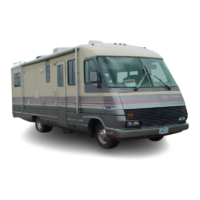To
release and
lower
the
shade:
Move
the
cord
toward
the
center
of
the
shade, pull
cord
slightly
to
release lock. Lower
as
desired.
If
the
shade stops
lowering, move the cord
to
the center
of
the
shade
and release again.
The shade may occasionally
lock in
the
full up posi-
tion.
To
release, grasp
the
lock
mechanism (see
illustration)'
and slide
it
down.
A
slight
upward
pressure·
on
the
bottom
of
the
shade may help
to
relieve
tension
on cord.
Care and M ainteliance:
""',
'.'
PeriodicallY.·vacuu~.
shades.":;"
.
:-:"';;---'
-<,,,,
'''-,'-
-:
..
",
Periodically spray
the
pulleys and
grommets
with
a lightJ,J!icone
lubrlc!lnt,:
.
" , .
'.
'::-
:',.
Eme~ge~o/~,E,,'f;!~i,yti~fr~'!f''''f<';'r;·;;(L,,!.·f
,
....
Theemergii'licYr6xif
llliilicl0vv;pro\lides
ian
escape
route
..
In ,case
themoto(homs·,.must
be.js)(acuated
o
Always
keep
tools
and
equipment
stored
in 'areas
where they
will
not
shift
while
traveling.
• Whenever possible, place
heavy
articles in storage
compartments
which
are
low
and in
the
best
loea·
tion
for
better
weight
distribution.
See
"WEIGHING"
section.
o Pack articles carefully in the storage
compartments
to
minimize
shifting.
If
necessary, use
straps
to
prevent movement.
•
Be
sure liquid containers are'
capped
and
cannot
tip
or
spill. Secure all glass
containers
and
dishes
before traveling
•
o Exterior storage
compartments
may
not
be
watef-
tight
in all
climate
conditions.
Carry
any
articles
which could be damaged by
water
inside
the
motor
.
nome..
,
WARNING: OUTSIDE STORAGE COMPART-
......
··.i.rnder.emetgMcy;c()n1fit!oh~itrdfCt~'e'i8'ietn'S.'Window,c·
.
pull.the
red handleCsl"and
pull'"
thll'\vindovVout.
The .
window
will
fall to
the
ground. The
window
may
be
removed
for
cleaning,
but
be sure
to
catch
it
after
"I\1,EN,TS 'ARE NOT SEALED, VENTED ENCLO-
SURES,
AND
MAY
BE
ACCESSIBLE
FROM
IN-
SIDE.
THE.' MOTOR HOME. DO NOT STORE
FLAM/VIABLE, VOLATILE LIQUIDS,
HAZARDOUS
CHEMICALS
OR
EQUIPMENT IN THESE AREAS.
releasing
the
handles.
.,'
Emergency
Exit
Window
STORAGE
Exterior
Compartments
Exterior
storage
compartments
maximize available
space and should accommodate
most
of
your storage
needs. They; have been
designedW
remain secure
while
the 'vehicle is in
motion.
All
of
the
storage
com-
pa'rtments
except
the
LP
gas and generator
compart-
ments
can be locked. Fire-prevention regulations re-
quire
that
the
LP
gas and generator
compartments
be unlocked
at
all times.
Please note
that
if
all
compartments
are filled
with
heavy,
or
densely
packed items, your
motor
home
could
be
overloaded. Refer to the
section
in
this
manual
that
discusses
capacity
and weighing. Follow
the loading and weighing instructions in that section.
When
storing
equipment and supplies:
intt?rior
~tor,age
,,·iterior storage areas
may
be
found
in a
number
of
places in your
motor
'home - overhead
compart-
'.
ments,wall,closets,
under
the
dinette,
under
the
bed,
iavyand
'galley cabinets.
Most
of
the
closets
and
.cabinets have
hidden
.fatches
along
one
edge
of
the
door. Press
the
latch
button
to
open
the
door.
Overheaddoors
may
have'
friction
supports
to
hold
them
open.
Drawers rest in
detent
notches
when
they
are
closed.
To
open drawers,
lift
up slightly, then pull open.
Closets
may
be equipped
with
12-volt
lights
that
may be
switched
to
turn
ON
when
the
closet
door
is opened.
Be
sure
the
light
goes OFF
when
you
close
the
closet
door -
your
battery
could
be
discharged
rapidly
if it
stays ON.
If
the
light
stays
on
when
the
door
is
closed.
the
door
switch
requires
adjustment.
The same loading
considerations
apply
to
interior
storage areas
as
to
exterior. Even
though
your
motor
home has a
lot
of
storage space, use
good
sense
.,
'when
loading.
Consult
the
section.
on
capacity
and
'w~ighing;"_'-"
' . "
18
INTERIOR
AND
FURNISHINGS
The materials used inside your
motor
home
have
been selected for
durability
and
comfort.
With
reasonable care, these materials
will
stand
up
under
years
of
recreational living. The
MAINTENANCE
SEC-
TION
in this manual
outlines
care
requirements
for
the various upholstery fabrics, floor, cabinet, and
wall
finishes.

